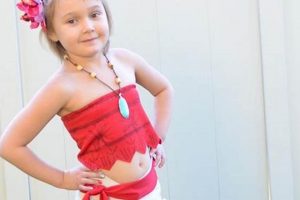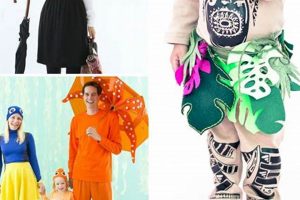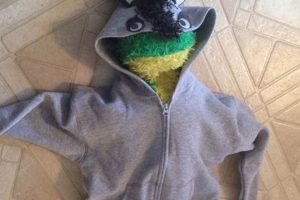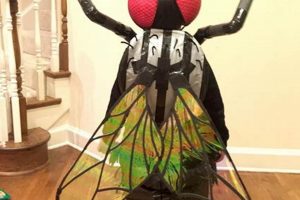Creating a lupine-inspired disguise at home involves the crafting of attire that emulates the appearance of a wolf. This encompasses constructing elements such as ears, a tail, and simulating fur, often through readily available materials and personal ingenuity. For instance, a person might utilize felt, faux fur fabric, and cardboard to fashion a complete set of wolf-like accessories to be worn with coordinating clothing.
The appeal of constructing such attire stems from several factors. It offers a cost-effective alternative to purchasing pre-made ensembles. Furthermore, the personalized nature of the process allows for unique expression and customization, resulting in an outfit that distinctly reflects the wearer’s creative vision. Historically, the practice of creating animalistic representations for celebratory or theatrical purposes has existed across numerous cultures, demonstrating a deep-seated human fascination with transforming one’s identity.
The subsequent sections will provide detailed guidance on selecting appropriate materials, outlining effective construction techniques for key components, and offering suggestions for achieving a realistic and impactful visual outcome.
Crafting an Authentic Lupine Disguise
Achieving a convincing representation of a wolf through homemade attire requires careful consideration of various factors. The following guidance aims to enhance the realism and durability of the resulting garment.
Tip 1: Material Selection: Prioritize high-quality faux fur fabrics for the primary components. Opt for varying pile lengths and textures to mimic the natural density and variation of a wolf’s coat. Consider incorporating multiple shades of grey, brown, and white to create depth and visual interest.
Tip 2: Ear Construction: The ears are a critical element. Use a sturdy internal structure, such as cardboard or craft foam, to maintain their shape. Securely attach the faux fur to the structure, ensuring a clean and seamless finish. Pay attention to the ear’s curvature and angle for accurate anatomical representation.
Tip 3: Tail Design: A well-constructed tail significantly enhances the overall effect. Consider the tail’s length, thickness, and curvature. Employ a flexible wire armature within the tail to allow for controlled movement and posing. Gradual tapering of the tail’s width contributes to a more natural appearance.
Tip 4: Mask Considerations: If incorporating a mask, prioritize comfort and visibility. Ensure adequate ventilation to prevent overheating. Use non-toxic paints and adhesives. The mask should seamlessly integrate with the rest of the attire, maintaining the consistent lupine aesthetic.
Tip 5: Color Palette: Research the diverse color variations within wolf species. Avoid overly saturated or artificial colors. Opt for muted and earthy tones to achieve a realistic representation. Pay attention to the subtle gradations and patterns found in natural wolf fur.
Tip 6: Attention to Detail: Small details can significantly elevate the quality of the attire. Consider adding subtle markings or patterns to the faux fur using fabric markers or airbrush techniques. Incorporate claws or paw-like gloves to complete the transformation.
Tip 7: Durability and Reinforcement: Ensure that all seams are securely stitched and reinforced. Use durable thread and appropriate stitching techniques. Consider adding a lining to the interior of the costume to enhance comfort and durability.
Adherence to these guidelines will contribute to the creation of a visually compelling and enduring lupine representation, surpassing the quality of readily available, mass-produced alternatives.
The following sections will delve into specific construction techniques and offer practical advice for assembling the individual components of the costume.
1. Material Authenticity
The verisimilitude of a homemade lupine disguise is intrinsically linked to the selection of materials that convincingly replicate the textures and coloration of a wolf’s pelage. The authenticity of these materials dictates the overall visual impact and believability of the resulting attire.
- Faux Fur Fiber Composition
The type of synthetic fibers used in faux fur directly impacts its realism. Acrylic fibers, while cost-effective, often possess an unnatural sheen and lack the suppleness of modacrylic or high-quality polyester. These superior fibers more closely mimic the feel and drape of natural fur, enhancing the overall authenticity. The choice of fiber composition also influences the material’s durability and resistance to wear and tear.
- Color and Pattern Fidelity
Achieving a realistic representation necessitates careful attention to the color palette and pattern variations found in natural wolf pelts. Utilizing a blend of complementary shades, such as greys, browns, blacks, and creams, is crucial. Complex, multi-tonal faux furs, often featuring subtle gradients and guard hair effects, contribute to a more convincing appearance compared to single-tone or overly uniform materials. The proper replication of these natural color variations significantly elevates the project’s authenticity.
- Pile Length and Density
The pile length, or the length of the individual fibers, and the density, or the number of fibers per unit area, are critical considerations. Variations in pile length across different areas of the costume can mimic the natural variations found on a wolf’s body. A dense pile provides a fuller, more luxurious appearance, while a sparser pile may be suitable for areas requiring greater flexibility or breathability. Careful attention to these parameters enhances the realism and textural accuracy of the attire.
- Backing Material and Drape
The backing material supporting the faux fur fibers influences the overall drape and structure of the material. A flexible and pliable backing allows the material to conform naturally to the body, enhancing comfort and realism. Stiffer backings may result in a more rigid and unnatural appearance. The backing material’s durability also affects the garment’s longevity and resistance to tearing or stretching.
The cumulative effect of these material properties significantly contributes to the success of the project. Choosing authentic-looking materials results in a homemade garment that closely emulates the visual characteristics of a real wolf, transforming the wearer into a believable embodiment of the animal. Conversely, compromising on material quality can detract from the overall effect, resulting in an artificial and unconvincing disguise.
2. Pattern Accuracy
Within the context of creating a lupine-inspired disguise at home, pattern accuracy constitutes a critical determinant of the final product’s verisimilitude. Inac
curate patterns precipitate a cascade of negative effects, ranging from an ill-fitting garment to a distorted and unconvincing representation of a wolf. The shapes and sizes of individual components, such as the head, torso, limbs, and tail, must adhere to anatomical proportions to achieve a recognizable and aesthetically pleasing result. A pattern that deviates significantly from these proportions will yield an attire that fails to evoke the intended animal.
Real-world examples highlight the practical significance of pattern accuracy. A wolf head mask pattern lacking precise shaping around the muzzle and jawline will result in a mask that appears misshapen and unnatural. Similarly, a tail pattern failing to account for the appropriate taper and curvature will produce a tail that hangs awkwardly or appears disproportionately thick. Costumes created using meticulously drafted and tested patterns, conversely, exhibit superior fit, movement, and visual impact. Consider the case of theatrical productions, where costume designers invest substantial time in pattern development to ensure the performers’ attire accurately portrays the intended characters, thereby enhancing the overall audience experience. The development is frequently an iterative process, involving multiple prototypes and adjustments to achieve optimal pattern accuracy.
In summation, pattern accuracy serves as a cornerstone in the creation of a believable lupine disguise. Its influence extends beyond mere aesthetics, impacting the wearer’s comfort, range of motion, and overall satisfaction with the finished product. Challenges associated with pattern creation, such as a lack of drafting skills or access to accurate anatomical references, can be mitigated through the utilization of commercially available patterns, online tutorials, or consultation with experienced seamstresses. Ultimately, prioritizing pattern accuracy is essential for achieving a successful and visually compelling outcome.
3. Construction Durability
The longevity and functionality of any homemade attire, including a lupine-inspired disguise, are directly contingent upon the robustness of its construction. Durability ensures that the costume can withstand repeated wear, handling, and potential exposure to various environmental conditions. A poorly constructed outfit may be prone to tearing, seam failure, and component detachment, rendering it unsuitable for its intended purpose.
- Seam Reinforcement and Stitch Selection
The integrity of seams is paramount to the overall durability. Employing appropriate stitch types, such as a reinforced straight stitch or a zigzag stitch for stretch fabrics, is crucial. Reinforcing stress points, such as the attachment points of ears or tails, with additional stitching or fabric patches prevents premature failure. Improper seam construction can lead to unraveling and structural collapse of the attire. Consider the impact of heavy use on a theatrical wolf costume; reinforced seams are essential for enduring rigorous performances.
- Material Selection and Compatibility
The selection of inherently durable materials and ensuring compatibility between different fabrics and components contribute significantly to longevity. Using high-quality faux fur, strong thread, and resilient backing materials enhances the costume’s resistance to wear and tear. Incompatible materials may result in differential shrinkage or stretching, leading to distortion and structural weakening. For instance, pairing a delicate faux fur with a rigid, non-stretch lining can cause stress and eventual tearing.
- Fastener Security and Placement
Zippers, buttons, snaps, and hook-and-loop fasteners serve as critical components for securing the costume. Ensuring that these fasteners are securely attached and appropriately placed is essential for proper fit and functionality. Weak or poorly positioned fasteners can lead to garment malfunction or even injury. Commercial wolf costumes intended for rigorous use often feature heavy-duty zippers and reinforced attachment points to withstand repeated opening and closing.
- Lining and Interfacing Application
Incorporating linings and interfacings provides additional structural support and protection to the outer layers of the costume. Linings prevent stretching and distortion of the main fabric, while interfacings add stiffness and shape to collars, cuffs, and other structural elements. Proper application of these materials enhances the overall durability and appearance of the attire. The inner structure of a well-made wolf mask, for example, might utilize a stiff interfacing to maintain its shape and prevent deformation.
These considerations collectively underscore the vital role of construction durability in determining the long-term usability and aesthetic appeal of a self-made lupine disguise. A well-constructed outfit, utilizing appropriate materials, techniques, and reinforcement measures, will withstand repeated wear and provide a lasting representation of the intended animal. Conversely, neglecting these aspects can result in a costume that quickly deteriorates, diminishing its value and visual impact.
4. Wearer Comfort
Wearer comfort, in the context of constructing a lupine-inspired disguise at home, represents a critical and often overlooked factor influencing the overall success and utility of the attire. The inherent connection lies in the direct impact of comfort levels on the wearer’s ability to effectively inhabit and perform within the constructed character. Discomfort, arising from factors such as ill-fitting components, restrictive materials, or inadequate ventilation, can detract from the intended illusion and limit the wearer’s participation in related activities. For example, a mask designed without sufficient airflow may lead to overheating and restricted breathing, quickly diminishing the wearer’s enjoyment and potentially causing physical distress. Similarly, a costume made from stiff, non-breathable fabrics can limit movement and cause chafing, making extended wear unbearable. The practical significance of prioritizing wearer comfort stems from the desire to create an immersive and enjoyable experience, transforming the act of wearing the costume from a chore into a genuine expression of character.
Furthermore, considering comfort extends beyond mere physical sensations. The psychological comfort derived from a well-fitting and aesthetically pleasing costume also contributes to the wearer’s confidence and performance. A costume that fits poorly or looks unconvincing can induce self-consciousness and detract from the wearer’s ability to fully engage in the intended role. The impact of wearer comfort is particularly evident in professional theatrical productions, where costume designers prioritize both aesthetic accuracy and the performers’ ability to move, breathe, and speak comfortably. These costumes often incorporate specialized features such as breathable linings, flexible joints, and adjustable closures to ensure optimal comfort and performance. Similarly, homemade lupine attire can benefit from incorporating features such as adjustable straps, elasticized waistbands, and strategically placed ventilation openings to enhance comfort and facilitate movement.
In conclusion, the relationship between wearer comfort and the success of a wolf diy costume is inextricably linked. Prioritizing comfort not only enhan
ces the wearer’s physical well-being but also contributes to their psychological confidence and ability to fully embody the intended character. Challenges related to achieving optimal comfort can be addressed through careful material selection, meticulous pattern drafting, and the incorporation of adjustable and breathable features. By recognizing and addressing the importance of wearer comfort, creators can transform a mere costume into a truly immersive and enjoyable experience, allowing individuals to fully express their creativity and imagination.
5. Visual Impact
The visual impact of a self-constructed lupine disguise serves as a primary measure of its success. This impact, defined as the immediate and lasting impression created on an observer, is directly influenced by the quality and execution of the costume’s design and construction. A strong visual impact signifies that the attire effectively communicates the intended character, evoking a sense of realism, authenticity, or artistic interpretation. Conversely, a weak visual impact suggests deficiencies in design, construction, or material selection, resulting in an unconvincing or underwhelming representation. The cause-and-effect relationship is clear: meticulous attention to detail and a commitment to quality construction directly translate into a more compelling visual presentation.
The importance of visual impact in the context of a wolf diy costume extends beyond mere aesthetics. A well-designed and executed costume enhances the wearer’s experience, fostering a sense of confidence and immersion in the chosen persona. It also significantly impacts the reactions and perceptions of others, whether in a social setting, a theatrical performance, or a creative project. Consider the example of cosplayers at a convention: those whose costumes exhibit a high degree of visual fidelity and craftsmanship often garner greater attention and recognition, demonstrating the tangible benefits of a strong visual impact. Similarly, a theatrical production relying on homemade costumes benefits from the enhanced credibility and audience engagement that visually compelling attire provides. The practical application of this understanding lies in the conscious decision to prioritize elements such as accurate anatomical proportions, realistic color palettes, and meticulous detailing during the design and construction process.
In summary, the visual impact represents a crucial element of a wolf diy costume, serving as a tangible indicator of its overall quality and effectiveness. Achieving a strong visual impact requires a commitment to meticulous design, skilled craftsmanship, and thoughtful material selection. While challenges such as limited resources or technical expertise may present obstacles, prioritizing visual impact remains essential for creating a truly compelling and memorable representation. The pursuit of visual excellence, therefore, is not merely an aesthetic consideration but a fundamental aspect of realizing the full potential of the creative endeavor.
6. Accessory Integration
Accessory integration, within the context of crafting a lupine-inspired disguise, denotes the strategic incorporation of supplementary elements to enhance the costume’s overall visual coherence and fidelity. The connection between this integration and the success of a wolf diy costume resides in the principle that isolated components, however well-crafted, lack the cohesive impact of a unified ensemble. The absence of carefully considered accessories can diminish the illusion, rendering the disguise incomplete or unconvincing. The inclusion of elements such as ears, a tail, paws or gloves, and potentially a mask or facial prosthetics, serves to amplify the wolf-like qualities and contribute to a more immersive and believable transformation. The importance of this lies in its ability to complete the narrative of the attire, making it more than just a collection of parts.
Real-life examples of this principle abound in both amateur and professional costuming. A rudimentary illustration involves a simple wolf ear headband. While functional in suggesting lupine characteristics, its effect is significantly amplified when paired with faux fur gloves mimicking paws and a tail that echoes the ear’s color and texture. In more elaborate instances, such as theatrical productions, accessory integration demands meticulous planning. Each accessory, from the curvature of the canines in a prosthetic snout to the texture of individual hairs on a glove, must align with the overall design to create a seamless and convincing portrayal. Moreover, effective accessory integration should also consider functionality. For instance, a wolf paw constructed for a stage performer must allow for grasping objects and executing nuanced movements. The practical significance of this understanding lies in its application to every stage of the design and construction process, from initial conceptualization to final assembly.
In summary, accessory integration constitutes an indispensable element in the successful creation of a wolf diy costume. Its strategic application enhances visual coherence, amplifies the lupine characteristics, and contributes to a more immersive and believable transformation. Challenges associated with accessory design and construction, such as material sourcing or technical skill deficits, can be mitigated through diligent research, experimentation, and resourcefulness. The effective integration of accessories, therefore, is not merely an aesthetic consideration but a fundamental aspect of achieving a compelling and convincing portrayal.
7. Movement Allowance
Movement allowance, in the context of creating a lupine-inspired disguise, represents the degree of unrestricted mobility afforded to the wearer while donning the attire. This attribute significantly influences both the practicality and performative potential of the resulting costume. Adequate movement allowance enables the wearer to execute a range of gestures and actions appropriate to the intended character, enhancing the overall believability and impact of the portrayal. Conversely, insufficient allowance restricts mobility, detracting from the wearer’s ability to fully embody the lupine persona.
- Torso Flexibility
The torso section of a wolf costume necessitates a balance between form-fitting aesthetics and freedom of movement. Restrictive materials or poorly designed patterns can inhibit bending, twisting, and reaching motions. In theatrical productions, performers portraying wolves require the ability to execute complex choreography, demanding ample torso flexibility. Commercial costumes designed for active use often incorporate stretch panels or gussets in the torso area to accommodate a wide range of movements. Limited torso flexibility diminishes the wearer’s capacity to convincingly portray a dynamic and agile lupine character.
- Limb Articulation
The limbs, particularly the arms and legs, require unrestricted articulation to facilitate natural and convincing gaits, gestures, and interactions. Sleeves and pant legs that are too tight or improperly shaped can impede joint movement, leading to discomfort and restricted mobility. Costumes designed for cosplay
or performance often utilize articulated joints or flexible materials in the limb sections to enhance range of motion. An example is the incorporation of strategically placed gussets at the elbows and knees to allow for unrestricted bending. Limited limb articulation can result in stiff and unnatural movements, detracting from the overall realism of the attire. - Head and Neck Mobility
A wolf head or mask should allow for a reasonable degree of head and neck movement to enable the wearer to effectively communicate and interact with their surroundings. Overly rigid or restrictive headpieces can limit peripheral vision and impede the wearer’s ability to turn their head freely. Costumes designed for safety-conscious environments, such as mascot appearances, prioritize unrestricted head and neck movement to prevent potential accidents. A poorly designed headpiece that restricts movement can create a sense of isolation and disorientation, hindering the wearer’s ability to fully engage with their environment.
- Tail Maneuverability
The tail, while primarily a visual element, can also contribute to movement allowance. A tail that is too long, heavy, or inflexible can impede walking, running, or sitting. Costumes designed for practicality often incorporate a flexible internal structure or a detachable tail to minimize interference with movement. Commercial wolf costumes intended for parades or outdoor events may feature a shortened tail or a design that allows it to be easily adjusted or removed. A tail that restricts movement can become a hindrance, detracting from the wearer’s ability to comfortably and confidently navigate their surroundings.
These considerations collectively emphasize the integral role of movement allowance in the design and construction of a wolf diy costume. Attire that effectively balances aesthetic appeal with functional mobility enhances the wearer’s experience, allowing for a more immersive and convincing portrayal of the lupine character. Overcoming challenges associated with achieving optimal movement allowance requires careful planning, appropriate material selection, and a thorough understanding of anatomical constraints and performance requirements.
Frequently Asked Questions
This section addresses common inquiries and misconceptions pertaining to the creation and implementation of self-made lupine-inspired attire.
Question 1: What are the most cost-effective materials for constructing a realistic-looking faux fur tail?
Answer: Fleece fabric, combined with careful dyeing techniques and strategic trimming, provides a budget-friendly alternative to expensive faux fur. Stuffing the tail with recycled plastic bags or fabric scraps further reduces material costs.
Question 2: How can one prevent overheating while wearing a full-body wolf costume?
Answer: Implementing strategically placed ventilation openings, particularly in the mask and torso areas, facilitates airflow. Opting for breathable lining materials, such as cotton or moisture-wicking fabrics, further mitigates heat buildup.
Question 3: What are the best methods for attaching wolf ears securely to a wig or headpiece?
Answer: Sewing the ears directly to the wig cap with reinforced stitching ensures stability. Alternatively, utilizing strong adhesives, such as fabric glue or hot glue, provides a quick and reliable attachment method. Consider the weight of the ears when selecting an attachment technique.
Question 4: How can a realistic wolf paw effect be achieved without hindering hand dexterity?
Answer: Creating separate paw-shaped gloves with individual finger stalls allows for maximum dexterity. Attaching sculpted claws made from craft foam or resin to the glove fingertips completes the illusion without significantly impeding hand movement.
Question 5: What are some effective techniques for creating realistic wolf fur textures on a limited budget?
Answer: Utilizing inexpensive paintbrushes and diluted fabric paints to create subtle variations in color and texture on the faux fur can enhance realism. Strategic trimming and layering of different faux fur fabrics can further simulate the depth and complexity of natural wolf fur.
Question 6: How can one ensure that a homemade wolf costume adheres to safety guidelines at public events or conventions?
Answer: Prioritizing visibility, particularly in low-light conditions, by incorporating reflective elements or LED lighting is crucial. Ensuring that the costume allows for unrestricted movement and clear visibility prevents accidents. Adhering to event-specific costume guidelines and regulations is also essential.
The creation of a compelling wolf-inspired disguise necessitates a balance of creativity, resourcefulness, and attention to detail. Addressing potential challenges and prioritizing safety are paramount to achieving a successful and enjoyable outcome.
The following sections will delve into advanced techniques for enhancing the realism and durability of wolf costumes.
Conclusion
The construction of a “wolf diy costume” represents a multifaceted endeavor demanding a synthesis of artistic vision, technical skill, and practical considerations. The preceding discourse has explored critical facets of this undertaking, encompassing material selection, pattern accuracy, construction durability, wearer comfort, visual impact, accessory integration, and movement allowance. Mastery of these elements is paramount to achieving a convincing and enduring representation.
The enduring allure of crafting a “wolf diy costume” stems from its capacity to transcend mere imitation, fostering a deeper engagement with the symbolic power of the animal archetype. Individuals are encouraged to approach this endeavor with diligence, creativity, and a commitment to excellence, ensuring that the resulting attire not only embodies the physical characteristics of the wolf, but also reflects the wearer’s unique artistic expression. Future advancements in materials and construction techniques promise to further refine the art of creating lupine-inspired disguises, expanding the possibilities for self-expression and imaginative exploration.







